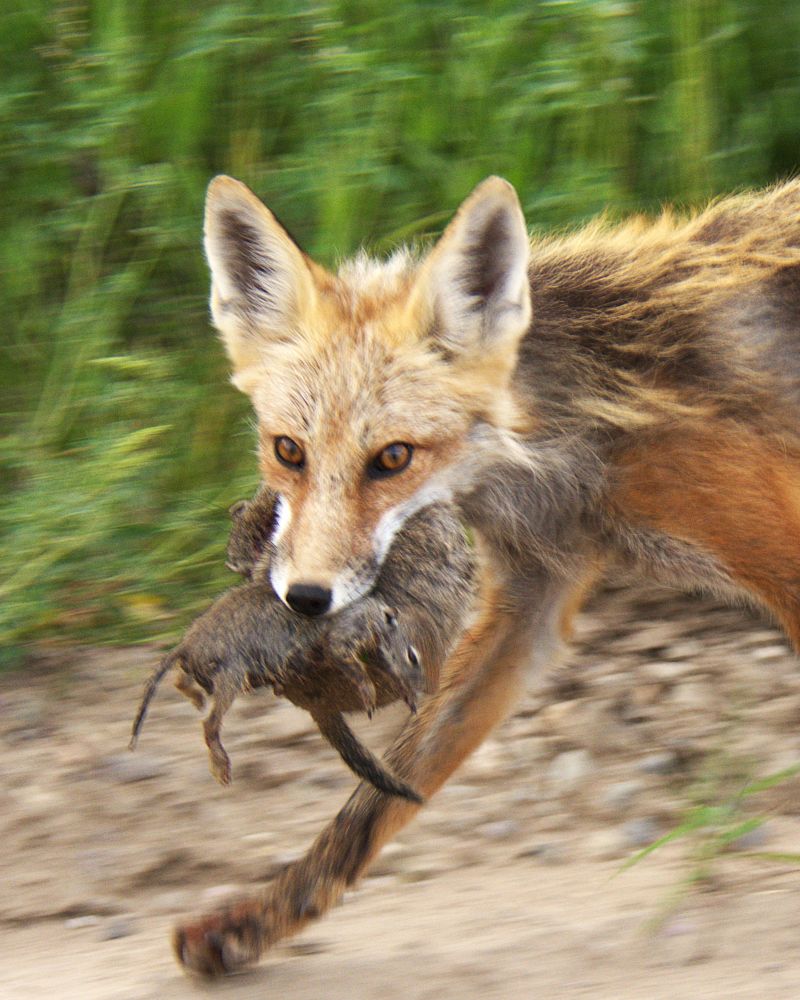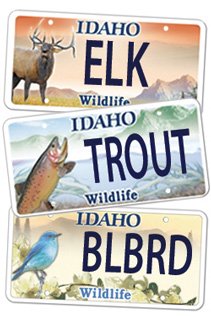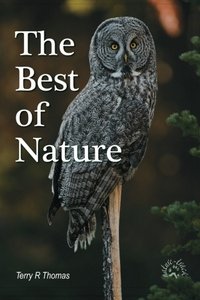Death and Dying

Copyright TerryR.Thomas/nature-track.com
This red fox is carrying a mouthful of ground squirrels back to his den to feed a litter of growing pups. This is in addition to the squirrels he will need to eat to maintain his own body.
It was evening in the Florida panhandle, and we were at a small lake surrounded by tall, Spanish moss-draped cypress trees. In the clear blue skies, we could see dozens of black vultures and turkey vultures. I could not get a full count, but there were several hundred at least. This particular lake was a nightly roosting area and the birds were congregating after a day scouting the surrounding area for miles in every direction looking for something dead to feast on.
I wondered, and not for the first time, what do all these vultures eat? Can there be that much death out there each day to sustain all these scavengers? I could not even comprehend how many dead critters it would take to fill the bellies of these birds and I wondered how many of them went to bed hungry each night.
Recently, in Arizona we saw numerous roost trees where ten to fifty or more vultures would congregate each night. My Florida musings were repeated, this time in a desert environment where there are far fewer animals than in the tropical areas of Florida. How can there be enough death to sustain these populations 365 days a year? And yet, there must be, because Partners in Flight estimates that there are about 218 million of the two species worldwide.
Dying is apparently big business in the wilds. We saw this yet again when we drove around Ennis Lake, Montana last week. There were thousands of birds on the water and I quipped to my wife that it was a bad place to be a little fish. Mergansers, loons, grebes, ruddy ducks, redheads, buffleheads, coots, mallards, and more all plied these waters looking for a meal. Even those that are not carnivores feed on living protein when they can and the amount of animal biomass consumed each day by these birds is just astounding.
And that was just what we could see above the surface. Fishermen cast lures and flies, tempting trout with a final easy meal. Trout ate smaller fish and insect larva. Beetle larva and dragonfly naiads consumed anything smaller than themselves including siblings and conspecifics. Smaller insects fed on algae, but some fed on even smaller critters and so on down the line into the microscopic world.
On land, death is just as important. A single red fox requires eight mouse-sized prey animals each day (almost 3,000 a year if that is all it ate) just to break even calorically. Large owls can eat up to 12 small rodents a day. A barn owl, a medium-sized owl, can eat 1,000 a year, but a great-horned owl, a large owl, may consume 4,000 small rodents each year. Partners in Flight estimates that there are 5.7 million great horned owls from Alaska to Brazil, requiring almost 23 billion small rodents (three times the human population) a year to fuel them. And there are 223 other species of owls worldwide that need feeding each day or night.
Then we still need to feed the snakes and the weasels, the hawks, falcons and eagles, coyotes, bears, wolves, lions, bobcats, and badgers, flycatchers, bluebirds, magpies, bats, pine marten, mink, shrews, and otters, shorebirds, wading birds, thrashers, shrikes, spiders, dragonflies, and far more. And then there are still the animals such as tree squirrels that are not truly carnivores but that won’t pass up an easy meal of eggs or nestlings when they find one.
In short, to support living, there is a lot of dying going on every single hour of every single day in every single realm. The daily production necessary to maintain what is often referred to as the cycle of life or the food chain, is beyond astounding.
It is a reminder that it is a wildly complex yet interlinked world out there, one we really don’t have a very good handle on. And like the stacked-block game of Jenga, pulling out the wrong block can be disastrous. Encouraging county, state, and federal planners to be cautious and thoughtful should be Job 1 for citizens.
Help Idaho Wildlife
When we traveled across the state in October 2017, we visited most of the Idaho Department of Fish and Game wildlife management areas. Most of the vehicles we saw using the wildlife management areas did not have wildlife plates. Buying wildlife plates is a great way for non-hunters and hunters alike to support wildlife-based recreation like birding.
C'mon folks, let's help Idaho's wildlife by proudly buying and displaying a wildlife license plate on each of our vehicles!
See below for information on Idaho plates. Most states have wildlife plates so if you live outside Idaho, check with your state's wildlife department or vehicle licensing division for availability of state wildlife plates where you live.
And tell them that you heard about it from Nature-track.com!

Wildlife License Plates
Great news! as of 2024, there are three NEW designs for license plates. They still are bluebird, cutthroat trout and elk, but they are beautiful.
Idaho Wildlife license plates provide essential funding that benefits the great diversity of native plants and wildlife that are not hunted, fished or trapped—over 10,000 species or 98% of Idaho’s species diversity. Game species that share the same habitats (such as elk, deer, antelope, sage-grouse, salmon, trout) also benefit from these specialty plates.
No state tax dollars are provided for wildlife diversity, conservation education and recreation programs. Neither are any revenues from the sale of hunting or fishing licenses spent on nongame species. Instead, these species depend on direct donations, federal grants, fundraising initiatives—and the Idaho Wildlife license plates.
Both my vehicles have Bluebird Plates. I prefer the bluebird because the nongame program gets 70 percent of the money from bluebird plates, but only 60 percent of the money from elk and trout plates - 10 percent of the money from elk plates supports wildlife disease monitoring and testing programs (to benefit the livestock industry) and 10 percent from cutthroat plates supports non-motorized boat access.
Incidentally, in 2014, the Idaho Legislature denied the Department of Fish and Game the ability to add new plates or even to change the name of the elk and cutthroat plates (very specific) to wildlife and fish plates, a move that would have allowed for changing images occasionally and generating more revenue. It would seem that they believe that we Idahoans don't want a well funded wildlife program.
I think it is time we let the Legislature know that Idahoan support wildlife funding and that we would like to see these generic plates come to fruition.

"WOW. What a phenomenal piece you wrote. You are amazing." Jennifer Jackson
That is embarrassing, but actually a fairly typical response to my nature essays. Since The Best of Nature is created from the very best of 16 years of these nature essays published weekly in the Idaho Falls Post Register (online readership 70,000), it is a fine read. It covers a wide variety of topics including humorous glimpses of nature, philosophy, natural history, and conservation. Readers praise the style, breadth of subject matter and my ability to communicate complex and emotional topics in a relaxed and understandable manner.
Everyone can find something to love in this book. From teenagers to octogenarians, from the coffee shop to the school room, these nature essays are widely read and enjoyed.
Some of the essays here are my personal favorites, others seemed to strike a chord with readers. Most have an important message or lesson that will resonate with you. They are written with a goal to simultaneously entertain and educate about the wonderful workings of nature. Some will make you laugh out loud and others will bring a tear to the eye and warm your heart.
Readers Write:
"You hit a home run with your article on, Big Questions in Nature. It should be required reading for everyone who has lost touch with nature...great job!" Joe Chapman
"We enjoyed your column, Bloom Where Planted. Some of the best writing yet. The Post Register is fortunate to have your weekly columns." Lou Griffin.
To read more and to order a copy, click here or get the Kindle version
Copies are also available at:
Post Register
Island Park Builders Supply (upstairs)
Barnes and Noble in Idaho Falls
Harriman State Park, Island Park
Museum of Idaho
Valley Books, Jackson Wyoming
Avocet Corner Bookstore, Bear River National Wildlife Refuge, Brigham City, Utah
Craters of the Moon National Monument Bookstore, Arco, Idaho